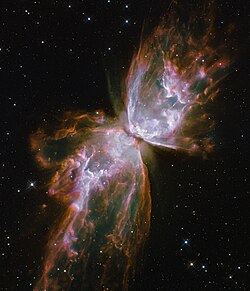| Emission nebula | |
|---|---|
| Planetary nebula | |
 NGC 6302, as taken by Hubble Space Telescope | |
| Observation data: J2000 epoch | |
| Right ascension | 17h 13m 44.211s [1] |
| Declination | −37° 06′ 15.94″ [1] |
| Distance | 3400 ± 500 [2] ly (1040 ± 160 [2] pc) |
| Apparent magnitude (V) | 7.1B [1] |
| Apparent dimensions (V) | >3′.0 [2] |
| Constellation | Scorpius |
| Physical characteristics | |
| Radius | >1.5 ± 0.2 ly [3] ly |
| Absolute magnitude (V) | -3.0B +0.4 −0.3 [4] |
| Notable features | Dual chemistry, hot central star |
| Designations | Bipolar Nebula, [1] Bug Nebula, [1] PK 349+01 1, [1] Butterfly Nebula, [5] [6] Sharpless 6, RCW 124, Gum 60, Caldwell 69 |
NGC 6302 (also known as the Bug Nebula, Butterfly Nebula, or Caldwell 69) is a bipolar type planetary nebula in the constellation Scorpius. The structure in this planetary nebula is among the most complex ever seen in any planetary nebulae. The spectrum of Butterfly Nebula shows that its central star is one of the hottest stars known, with a surface temperature in excess of 250,000 degrees Celsius. This implies that the star from which it formed must have been very large in order to become this hot.
Contents
- Observation history
- Characteristics
- Central star
- Dust chemistry
- See also
- Notes
- References
- External links
The central star, a white dwarf, was identified in 2009, using the upgraded Wide Field Camera 3 on board the Hubble Space Telescope. [7] The star has a current mass of around 0.64 solar masses. The star is surrounded by a dense equatorial disc composed of gas and dust. This dense disc is postulated to have caused the star's outflows to form the bipolar structure seen in the Nebula. [8] similar to an hourglass. This bipolar structure shows features such as ionization walls, knots and sharp edges to the lobes.
